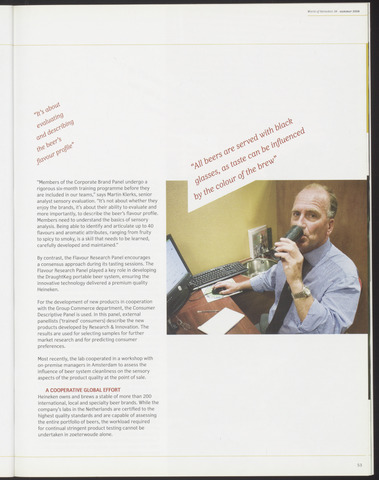„^e
World of Heineken 38 - summer 2008
id1
,cT
tf»'
ad
T<#
•'s
N°
,d
>e^s
•rt0>v&<*
>e
\AS
cec
;ed
"Members of the Corporate Brand Panel undergo a
rigorous six-month training programme before they
are included in our teams," says Martin Klerks, senior
analyst sensory evaluation. "It's not about whether they
enjoy the brands, it's about their ability to evaluate and
more importantly, to describe the beer's flavour profile.
Members need to understand the basics of sensory
analysis. Being able to identify and articulate up to 40
flavours and aromatic attributes, ranging from fruity
to spicy to smoky, is a skill that needs to be learned,
carefully developed and maintained."
By contrast, the Flavour Research Panel encourages
a consensus approach during its tasting sessions. The
Flavour Research Panel played a key role in developing
the DraughtKeg portable beer system, ensuring the
innovative technology delivered a premium quality
Heineken.
For the development of new products in cooperation
with the Group Commerce department, the Consumer
Descriptive Panel is used. In this panel, external
panellists ('trained' consumers) describe the new
products developed by Research Innovation. The
results are used for selecting samples for further
market research and for predicting consumer
preferences.
Most recently, the lab cooperated in a workshop with
on-premise managers in Amsterdam to assess the
influence of beer system cleanliness on the sensory
aspects of the product quality at the point of sale.
A COOPERATIVE GLOBAL EFFORT
Heineken owns and brews a stable of more than 200
international, local and specialty beer brands. While the
company's labs in the Netherlands are certified to the
highest quality standards and are capable of assessing
the entire portfolio of beers, the workload required
for continual stringent product testing cannot be
undertaken in zoeterwoude alone.
53

